|
|
|
|
![]()
|
|
|
| A Chieftain tank of IIBr Corps in action in a flooded area during the battle for the Lippe, 12 August | An RAF Nimrod closes on a conventional submarine forced to the surface by the Nimrod's attack. |
Action within this game is based on the study The Third World War August 1985 by General Sir John Hackett and others. Sir John commanded one of the two parachute brigades at Arnhem (Operation Market Garden); was wounded three times and received three decorations for gallantry; later he became Commander-in-Chief of the British Army of the Rhine and Commander of Northern Army Group, Nato. He was an Oxford scholar who went on to become Principal of King's College, London and President of both the UK Classical and English Associations.
The Third World War August 1985 received contributions on military matters from:
|
Air Chief Marshal Sir John Barraclough KCB CBE DFC AFC | |
|
Brigadier Kenneth Hunt OBE MC | |
|
Vice Admiral Sir Ian McGeoch KCB DSO DSC M.Phil. | |
|
Major General John Strawson CB OBE |
Political advice is from:
|
Norman Macrae, deputy editor of The Economist | |
|
Sir Bernhard Burrows GCMG, of the UK Diplomatic Service |
|
Roll of Honour |
|
|
Wargamers who make significant and lasting contributions to the development of WW3 |
|
Disclaimer:
Neither The War Office nor its members accept any responsibility or
liability for any loss or damage that may result from installing, or using WW3.
Basically, we've done our best, but if anything goes wrong, you're on your own.
Your feedback is welcome, as is constructive criticism; just remember that our work is provided to you free,
gratis and for nothing.
|
Load
West Front from your CD-ROM into a new folder. Name the folder WW3. | |
|
Set
the folder to view By Type; then delete all *.lcg, *.scn, *.scl, *.org, Army.oob, Corps.oob,
Division.oob and Brigade.oob files. | |
|
Delete
the Pictures folder. | |
|
Download
the latest version of World war Three, 9MB
| |
|
Copy
the new files and folder into the WW3 folder. |
If you installed the original version, you may upgrade now with WW3Patch7.zip, by unzipping into the WW3 file. There should be regular upgrades in future, so please check back here regularly.
Notes:
Although the above instructions work well and are followed 99.9% of the time, just occasionally a happy wargamer (shell shock, battle fatigue?) decides to abandon our guidelines and 'upgrade' WW3 with a WF patch. You'll notice that this is not in the above instructions and for a good reason - a WF patch will destroy WW3.
Our game includes an LCG. It works fine, but you will find some odd data floating about in the entry dialogues. A top ex-TS designer - no names, no pack drill ;-) - says this is unavoidable, as this data is "hardwired" into the wf.exe file. We are not sure that this is completely true and would welcome an LCG expert's contribution on this. Meanwhile, just carry on as before.
The editor here only ever battles in 2D (for an accurate perspective and to avoid possible confusion by camouflage); can hardly imagine how anyone could fight a battle in 3D; and so has not got around to changing all the 3D graphics. (Should be cashiered, at the least. Humph!) To make it simple, just avoid using unit bases in 3D, until some bright spark changes them, okay?
That's all there should be to it. Whew! Stand easy, soldier.
![]() If you'd like a shortcut to the game, copy and paste the WW3 shortcut
(ww3.ico) onto
your desktop, or use it for your start menu shortcut.
If you'd like a shortcut to the game, copy and paste the WW3 shortcut
(ww3.ico) onto
your desktop, or use it for your start menu shortcut.
The Third World War August 1985 now contains:
|
|||
|
1000 hrs: The Soviets have moved a long range gun, capable of delivering chemical payloads over long distances, within range of West European capitals. It is using a tunnel as a secure base. At or shortly after 1300 hrs, a US missile will hit the ventilation shaft of the tunnel and with luck force the gun into the open, in time for your force to destroy it. It won't hang about, so neither should you. It is strongly suggested that you use the terrain to get a view of enemy positions and movement. |
||
|
|||
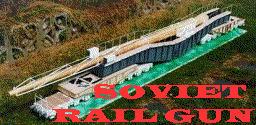 |
|||
|
The Soviets must break the Greenland-Iceland-Norway Gap. Here is what they regard as the weak link: a lonely U.S. base deep in an Icelandic snowfield. On Day 1 of this war, the Soviets cut all satellite links and now bad weather has closed in; freezing fog has grounded all aircraft. The U.S. engineers are alone in manning this radar station and air base; no help is on the way, but the Reds are. Artic-specialist commandos are closing in. |
||
|
|||
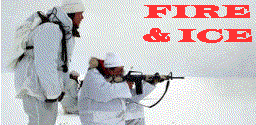 |
|||
|
In response to a flash alert, the commanding officer of the U.S. 32nd Armored Regiment is moving his troops up to the West German border with East Germany. His regiment is "light" and its duty is to act as a trip wire, so that Nato should not over-react to any incursion, other than to a deliberate, full-scale invasion by the Warsaw Pact. This is Natos' European Central Sector. |
||
|
|||
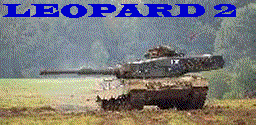 |
|||
|
Day 2. This is full-scale war and the armoured might of the Red Army is driving towards Fulda, in an attempt to reach the Rhine in the shortest possible time. Your job is to slow them down, whilst Nato fights to gain air superiority and air/sea convoys cross the Atlantic with the bulk of the U.S. military's commitment. |
||
|
|||
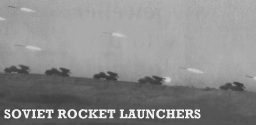 |
|||
|
Soviet forces continue their advance, which has been so rapid that the families of U.S. servicing personnel have not been able to be evacuated. They are on the main U.S. base here. You know your duty, I'm sure. |
||
|
|||
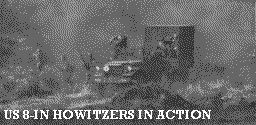 |
|||
|
Day 7. Maybe the Red Army has over-stretched itself. If Nato is to ever get in a counter-attack, you must hold both sides of this river. |
||
|
|||
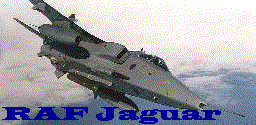 |
|||
|
Nato now has air superiority and reinforcements have arrived at the front line. If Nato can push the Red Army back, maybe the Soviet system will buckle. Up and at 'em! |
||
|
|||
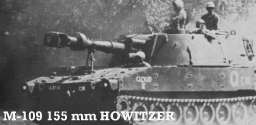 |
|||
|
Day 3. To stop U.S. reinforcements reaching Europe, the Soviet Union must break through the Greenland- Iceland- Norway gap, into the North Atlantic. Here, in the Artic Circle within Norway, Russian artic warfare troops will try and unstitch the eastern end of the defensive line. Norwegian troops are already in position and specialist, Royal Marine Commandos are arriving. U.S. forces are also on their way. Soviet forces must not be allowed to seize all the ports, or the Norwegian headquarters. | ||
|
|||
 |
|||
|
Here comes the cavalry! Unfortunately, Soviet forces made a successful, surprise attack on Iceland and allowed Red Navy surface and sub-surface vessels into the North Atlantic. They are supported by an aircraft carrier. Britain's Royal Navy is escorting ship-borne reinforcements, and the U.S.A.F. is also ferrying supplies across. Nato is relying on you to protect these desperately-needed supplies and reinforcements. | ||
|
|||
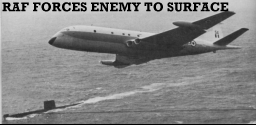 |
|||
|
As soon as the Alert goes out that the Soviets were massing on the German Border, the Nato Allies started deploying to their Defensive positions. Orders were issued and Nato readied themselves to repulse the massed armour that pre-war doctrine insisted the Soviets would use. They were right, however they also expected the elite Spetznaz to only be used behind their lines, not in the frontal attacks. Now, two Soviet Air Assault Battalions were hurtling towards they very positions Nato had to occupy to repulse the Armour. Only a few German infantry & Leopards hold the line for Nato. Who would get there first? | ||
|
|||
 |
|||
|
Day 1 0400 Hrs: Armour of II British Corps, with Dutch and West German support, must break through Soviet lines and cross the Rhine, opposed by a large force of Red armour. Operations will begin at first light. West German units will take the left flank, providing cover for the British thrust at the centre of Arnhem. Dutch units will then seize objectives and exploit opportunities. Initial surprise lies with Nato: this will be a wild ride. | ||
|
|||
 |
|||
|
The Soviets are becoming desperate, as Nato halts the Red Army and the Communist system in Moscow is crumbling. The local Soviet theatre commander has decided to make a tactical nuclear strike. His target: the British HQ at Paderborn. The only missile available to the Soviet commander is short range and as a result, he must move the missiles from Northeim. Intel reports suggest the target will enter your sector within one, or two hours from now.. Somewhere on that route, you must strike at the Frog-7 launching systems. Visibility is bad, due to rain and lateness of the day. This is all, or nothing. | ||
|
|||
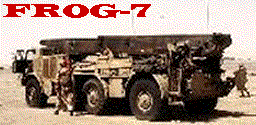 |
|||
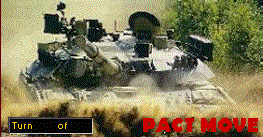 |
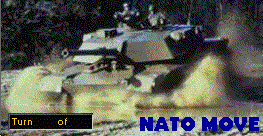 |
Although either Nato or Pact may be played against the AI, the underlying thought behind the game's design is for the player to be Nato, against the Warsaw Pact. The reason for this is simply that the AI does not play as well as a good gamester (judging by our own play) and therefore the AI needs many advantages to produce a challenging scenario.
These challenges are provided by the existing advantages enjoyed by Warsaw Pact forces:
|
The Soviets had more men and materiel that Nato. | |
|
The advantage of surprise lies with the attacker and in this game, that is the Warsaw Pact. |
Ground & Tactical Air Force Strengths in the Central Region
| Manpower |
Equiv. |
Tanks |
Artillery |
Armed |
Tactical |
|||
| Country |
'000 |
Divisions |
Medium |
Light |
ATGW |
all types |
Helis |
Fighters |
| NATO | ||||||||
| Belgium | 47 | 2 | 400 | 200 | 675 | 80 | 100 | 150 |
| Britain | 138 | 5 | 1050 | 500 | 2550 | 325 | 150 | 620 |
| Canada | 12 | 1 | 150 | - | 500 | 50 | 50 | 70 |
| Netherlands | 30 | 2 | 425 | 100 | 700 | 100 | 100 | 175 |
| West Germany | 800 | 14 | 3000 | 350 | 5750 | 1150 | 600 | 650 |
| United States | 250 | 7 | 2150 | 600 | 3500 | 1050 | 350 | 1150 |
| 1277 | 31 | 7175 | 1750 | 13675 | 2755 | 1350 | 2815 | |
| France | 90 | 5 | 750 | 250 | 1250 | 120 | 125 | 550 |
|
Totals: |
1367 | 36 | 7925 | 2000 | 14925 | 2875 | 1475 | 3365 |
| WARSAW PACT | ||||||||
| Czechoslovakia | 165 | 10 | 3000 | - | 1000 | 900 | 50 | 500 |
| East Germany | 100 | 6 | 1700 | 100 | 600 | 750 | 50 | 350 |
| Poland | 240 | 15 | 3000 | 250 | 1400 | 1500 | 50 | 800 |
| Soviet Union: | ||||||||
| in Eastern Europe | 425 | 28 | 8000 | 600 | 4300 | 3600 | 700 | 1300 |
| in Western USSR | 495 | 34 | 9000 | 700 | 5200 | 4500 | 850 | 1500 |
|
Soviet Total: |
920 | 62 | 17000 | 1300 | 9500 | 8100 | 1550 | 2800 |
|
Totals: |
1425 | 93 | 24700 | 1650 | 12500 | 11250 | 1700 | 4450 |
|
Note that in certain, vital units, the Soviets outnumber Nato by these amounts: |
|
Medium Tanks: 16,775 |
|
Artillery: 8,375 |
|
Tactical Fighters: 1,085 |
These are the units that will do the most damage on the battlefield. One should also remember that although some experts discounted the quality of Soviet troops, due to their being conscripted and composed of different nationalities, with different languages, these factors are also true for Nato. Only the USA and the UK had fully-professional forces in 1985; and the USA had not yet recovered from its Viet Nam debâcle.
Therefore expect to be outnumbered by Soviet forces and be attacked by land, sea and air in coordinated thrusts. Russian Special Forces included Spetnatz, who were (and are) highly trained, battle-hardened and formidable. They may appear behind your lines at any time.
The Soviet assault is in columns, led by massed armour followed closely by mechanized infantry who will exit their vehicles to tackle obstacles. There is close air support, massed artillery and air cavalry assault.
During the Pact's assault phase and whilst Nato assembles its forces (an essential component being the US air-sea bridge from the continental USA to Europe), any Nato forces foolhardy enough to try and block the Soviet advance will be rapidly annihilated. Put another way: any Nato unit standing in open ground facing the advancing Soviet forces will be steam-rolled.
Nato reckoned that any delay or break in the US air-sea lift would allow the Pact to advance to the Atlantic in just two weeks. Only the British Isles (with its trusty tank trap, the English Channel) could have held out. This applies to you, playing Nato forces. You must therefore use other means to gain victory.
Nato battlefield tactics originate from European warfare millennia past. Across Europe is a series of large north-south running rivers. Each affords the defender the opportunity to build a defensive system that may punish the invader. Note punish - not stop necessarily.
Since the start of the Cold War, Nato officers have strolled across the North European plain. They have learned every knoll, clump of trees, stream and contour. Engineers have molded this countryside to afford every advantage. You must study the maps and discover them for yourself.
Apparently natural features allow you to position your forces to hit the enemy in their most vulnerable areas - side and rear armour. When their mechanized infantry try to counter-ambush you, pull out and move to your next position. You will lose ground (sorry, Germany), but gain points. Remember this: Nato is prepared to lose ground in order to save lives and punish the enemy; unnecessary dead will be most unwelcome.
You may notice a substantial difference between WW2 and WW3 firepower. Human flesh is as vulnerable as ever, as are soft-skinned vehicles. Armour has improved considerably, but when hit by a TOW missile is not much defence. As an example, think of the destruction of Israeli armour at the hands of Soviet Sam-equipped Egyptian infantry in the 1973 Yom Kippur war.
Battlefield tactics must take account of this increase in firepower. Remember that by far the largest proportion of casualties are caused, not by small arms, or armour, but by artillery (land and air). Best results are gained by using your mobile ground forces to contain and define the enemy, then bombard the enemy from guns and aircraft.
The time may come when, having reached the geographical limit of your theatre, you have to stand and fight. In this back-to-the-wall case, try to avoid allowing any unit to become the target of enemy forces - their concentrated fire is likely to be immediately overwhelming.
|
Use forestation and the urban landscape to reduce enemy fire-effectiveness. | |
|
Have HQs and officers nearby to maintain morale. | |
|
Remain hidden and allow enemy units to stumble across yours. | |
|
You can be sure that the enemy will move towards Objectives; there is no profit in leaving a strong position near an Objective. Movement may attract enemy fire. Remaining hidden, in a strong position near an Objective, will move the kill-rate to your advantage. | |
|
Finally, when no retreat is possible and one of your units finds itself in an exposed position facing the enemy (as a result, say, of retreat, or bombardment), do not waste Action Points moving it to cover (when the movement itself will attract fire). Face the enemy and fire until the end. |
We hope you find some of the same pleasure in WW3 as we have.